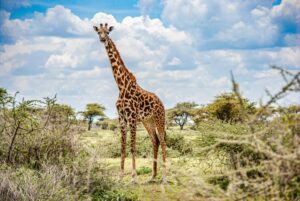A Dream for many Adventures
Embarking on a safari in Tanzania is a dream for many adventurers. This East African gem offers stunning landscapes, abundant wildlife, and unforgettable experiences. However, planning a Tanzania safari can feel overwhelming. Don’t worry! This guide will walk you through everything you need to know to plan the perfect safari adventure. Get ready to immerse yourself in the wild beauty of Tanzania!
1. Choose the Right Time to Visit
Timing is crucial when planning a safari. Tanzania’s dry season, from late June to October, is the best time for wildlife viewing. During these months, animals gather around waterholes, making them easier to spot. This period also coincides with the Great Migration, a spectacular event where millions of wildebeest and zebras move across the Serengeti.
However, the wet season (November to May) also has its perks. The landscape is lush and green, and it’s a great time for bird watching as migratory birds arrive. Plus, there are fewer tourists, which means a more intimate experience and lower prices.
2. Decide Where to Go
Tanzania is home to numerous national parks and game reserves, each offering unique experiences. Here are some must-visit locations:
Serengeti National Park
The Serengeti is synonymous with safari. Famous for the Great Migration and the Big Five (lion, elephant, buffalo, leopard, and rhino), this park is a must-see.
Ngorongoro Crater
This UNESCO World Heritage Site is a natural wonder. The crater is home to a dense population of wildlife, including the endangered black rhino. The lush landscape and diverse ecosystem make it a great spot for a day trip.
Tarangire National Park
Known for its large elephant herds and iconic baobab trees, Tarangire offers a unique safari experience. It’s less crowded than the Serengeti and Ngorongoro, making it perfect for those looking to avoid the crowds.
Selous Game Reserve
For a more remote and less touristy experience, visit Selous. It’s one of the largest faunal reserves in the world and offers a chance to see wild dogs, which are rare elsewhere.
3. Choose Your Safari Style
Your safari experience can vary greatly depending on your preferences and budget. Here are a few options:
Luxury Safari
If comfort is your priority, a luxury safari is the way to go. You’ll stay in high-end lodges or tented camps with all the amenities you could desire. These safaris often include private game drives, gourmet meals, and top-notch service.
Mid-Range Safari
A mid-range safari offers a balance between comfort and cost. You’ll stay in comfortable lodges or tented camps with good facilities. This option provides a great safari experience without breaking the bank.
Budget Safari
For the adventurous and budget-conscious, a budget safari is ideal. Accommodations are simpler, often involving camping or basic lodges. You’ll still get to experience the wildlife and landscapes, but with fewer frills.
Self-Drive Safari
If you’re feeling adventurous and confident in your navigation skills, consider a self-drive safari. This option gives you the freedom to explore at your own pace. However, it requires careful planning and a reliable 4×4 vehicle.
4. Plan Your Itinerary
A well-planned itinerary ensures you make the most of your safari. Here’s a sample 7-day itinerary to get you started:
Day 1-2: Arrival and Arusha National Park
- Arrive in Arusha and spend a day acclimatizing.
- Explore Arusha National Park, known for its diverse landscapes and wildlife.
Day 3-4: Serengeti National Park
- Drive or fly to the Serengeti.
- Spend two days exploring the park, witnessing the Great Migration and the Big Five.
Day 5: Ngorongoro Crater
- Head to Ngorongoro Crater for a day trip.
- Enjoy a picnic lunch while watching wildlife in the crater.
Day 6: Tarangire National Park
- Travel to Tarangire and spend the day on game drives.
- Marvel at the large elephant herds and unique baobab trees.
Day 7: Departure
- Return to Arusha for your flight home or onward travel.
5. Book Your Safari
Booking a safari involves several steps:
Choose a Reputable Safari Operator
Selecting a reliable safari operator is crucial for a successful trip. Look for operators with positive reviews, transparent pricing, and knowledgeable guides. Some recommended operators include:
- Asilia Africa
- &Beyond
- Nomad Tanzania
Reserve Your Accommodations
Once you’ve chosen your operator, book your accommodations. Whether you prefer luxury lodges or budget campsites, make sure to book well in advance, especially during peak season.
Arrange Transportation
Depending on your itinerary, you may need to book flights or arrange for a rental vehicle. Many safari operators include transportation in their packages, so check with them first.
6. Prepare for Your Safari
Proper preparation ensures a smooth and enjoyable safari experience.
Pack Wisely
Pack light, breathable clothing in neutral colors to blend in with the surroundings. Don’t forget essentials like a wide-brimmed hat, sunglasses, sunscreen, insect repellent, and comfortable walking shoes. Binoculars and a good camera are also must-haves for wildlife viewing and photography.
Health and Safety
Consult your doctor about necessary vaccinations and medications, such as anti-malarial tablets. It’s also wise to have travel insurance that covers medical emergencies and trip cancellations.
Learn Some Swahili
While many guides speak English, learning a few basic Swahili phrases can enhance your experience and help you connect with locals. Phrases like “Jambo” (Hello) and “Asante” (Thank you) are good to know.
7. Embrace the Experience
A safari is a unique adventure that immerses you in nature. Be patient and flexible, as wildlife sightings can be unpredictable. Listen to your guide, respect the animals and their habitat, and most importantly, enjoy every moment.
Planning a Tanzania safari may seem daunting, but with the right preparation, it can be an unforgettable adventure. From choosing the best time to visit and deciding where to go, to selecting your safari style and booking with a reputable operator, each step is crucial for a successful trip.
